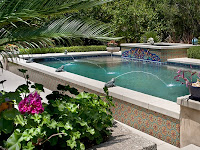High & Low Pool Filter PSI
A filter pressure gauge is used to measure a filter's PSI and every filter should be equipped with one.
The most obvious reason for high PSI is that the filter is dirty. Simply cleaning the filter or backwashing it if you have a D.E. Or Sand Filter will usually lower the PSI down to an acceptable range. The clean starting filter PSI will vary from filter to filter, some hover around 10-15 PSI but many cartridge filters start at 20 PSI. The best way to know in your case is to clean the filter and then mark on the gauge the clean PSI for your particular filter.
A general rule of thumb is that if the PSI goes up by 10, if it is at 15 and
goes up to 25, then a cleaning or backwashing is due. This is the best way to
lower high filter pressure and get the pool circulating again.
After cleaning the filter or backwashing it the filter pressure should drop. If
it goes back up within a day or week there could be a few reasons for this.
One, the grids or cartridges are worn out and need to be replaced. If you have
a Sand Filter the sand could be really dirty and you will need to clean it or
replace it. Also, if the pool was recently green or cloudy, the filter could be
getting filled up quickly with organic matter. Cleaning the filter again
usually will solve the issue. If the D.E. Filter grids have a tear or the top
manifold is cracked, the filter pressure can rise rapidly after cleaning.
If you have a Return Side cleaner connected to your pool like a Polaris 360,
the PSI may rise while it is connected due to the back pressure created by
closing off a return line and by the cleaners connection itself. This is normal
and nothing to be concerned about. The pressure may also be higher by as much
as 10 PSI when you switch the valves to spa mode. The back pressure created by
the spa jets will cause the filter pressure to rise. A water feature may also
cause the filter PSI to rise.
So these are the reasons why your pool filter pressure will rise.
If you have low pool filter pressure several things may also cause this. The most
common reason is some debris is stuck in the pool impeller, restricting it and
causing the pump to pull less water. A suction leak like a worn pump lid o-ring
will also cause low filter pressure. A problem with the pump's diffuser can
also cause this.
Some obvious causes are also a clogged pool pump basket, a clogged skimmer
basket, and low water in the pool. Too much suction at the side port towards a
suction side cleaner can also cause lower pool filter pressure. A clogged inlet
line can also be the cause of low filter pressure. If you have a variable speed
pump and you are running it at or below 1400 RPM, the filter pressure PSI will
also read low.
A broken filter gauge can also create a false PSI reading – either too high or
too low, so make sure the gauge is in good working order. They are easy to
change and it will only take you a couple of minutes to do it.
I mention that a flow gauge like the FlowVis would be a good investment and if
you want to get the best idea of your pool's actual flow, I suggest you install
one. That way no matter what the PSI on the gauge, you can see from the flow
meter how much water is flowing into the pool. This is the best way to monitor
your pool's actual flow.
Visit my Website: http://www.swimmingpoollearning.com/
eBook: https://www.swimmingpoollearning.com/swimming-pool-care-ebook

Comments
Post a Comment